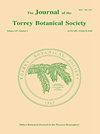西番莲的大地理等位酶变异
IF 0.8
4区 生物学
Q4 PLANT SCIENCES
引用次数: 3
摘要
美国南部,常见于老田野和路边。这草本,多年生藤本植物有雌雄同体的花,但是自交不亲和。大蜜蜂为这些花授粉,这些花产生的果实可以被哺乳动物吃掉。尽管有性繁殖模式表明基因有远距离传播的潜力,但该物种也显示出从根茎开始的广泛营养繁殖。营养繁殖可以减少种群内遗传变异的数量,增加种群间的分化。我们报道了在p.a nincarnata内的大地理等位酶变异。植物采集自南卡罗来纳州(SC)和乔治亚州(GA)三个地区。利用淀粉凝胶电泳技术收集了9个等位酶多态性位点的遗传数据。在来自SC和GA的168株植物样本中,我们观察到82种不同的多位点基因型。在区域内和区域间收集到具有相同多位点基因型的植株。遗传资料表明,区域间遗传差异不大。这些数据表明存在广泛的长距离基因运输,并且该物种可能严重依赖有性繁殖来建立新的栖息地。本文章由计算机程序翻译,如有差异,请以英文原文为准。
Macrogeographic allozyme variation in Passiflora incarnata
the southern United States and common in old fields and roadsides. This herbaceous, perennial vine has hermaphroditic flowers yet is self-incompatible. Large bees pollinate these flowers that produce fruits that may be eaten by mammals. Although the mode of sexual reproduction suggests the potential for long distance dispersal of genes, this species also displays extensive vegetative reproduction from rhizomes. Vegetative reproduction may reduce the amount of genetic variation within a population and increase differentiation among populations. We report on the macrogeographic allozymic variation within P. incarnata. Plants were collected from three regions in South Carolina (SC) and Georgia (GA). Genetic data were collected from nine polymorphic loci with starch gel electrophoresis of allozymes. In our sample of 168 plants from SC and GA, we observed 82 different multilocus genotypes. Plants with the same multilocus genotype were collected within and among regions. Genetic data indicated that there was little genetic differentiation among regions. These data suggest that there is extensive long distance transport of genes and that the species may rely heavily on sexual reproduction to establish new habitat.
求助全文
通过发布文献求助,成功后即可免费获取论文全文。
去求助
来源期刊
CiteScore
0.70
自引率
0.00%
发文量
16
审稿时长
>12 weeks
期刊介绍:
The Journal of the Torrey Botanical Society (until 1997 the Bulletin of the Torrey Botanical Club), the oldest botanical journal in the Americas, has as its primary goal the dissemination of scientific knowledge about plants (including thallopyhtes and fungi). It publishes basic research in all areas of plant biology, except horticulture, with an emphasis on research done in, and about plants of, the Western Hemisphere.

 求助内容:
求助内容: 应助结果提醒方式:
应助结果提醒方式:


